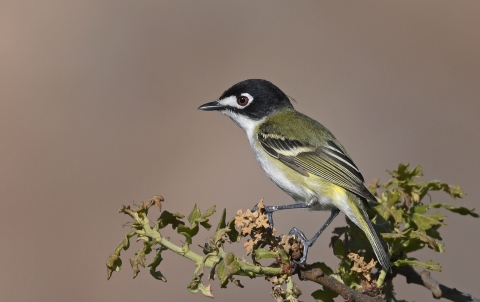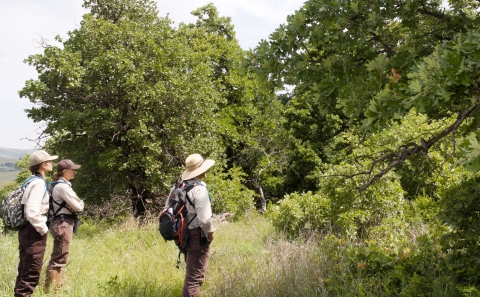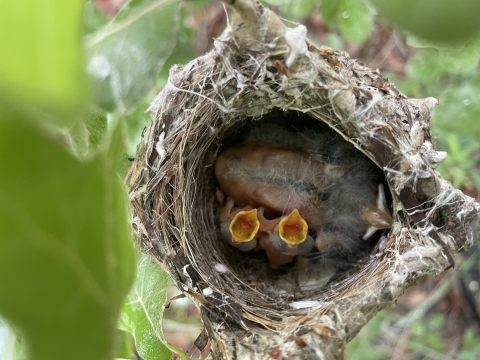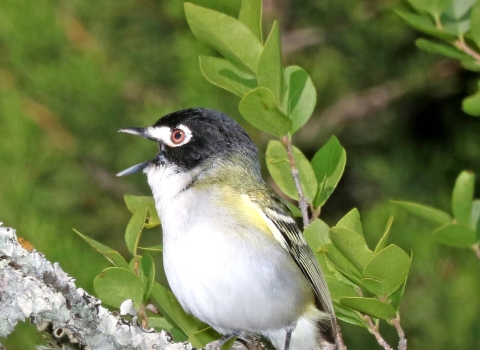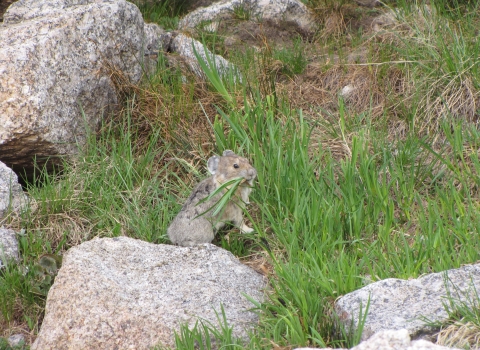The black-capped vireo (Vireo atricapilla) is a conversational migratory songbird, with one of the most varied songs in the vireo genus. Males make full use of their song catalogs during the mating season, as they search for mates or defend their small territories. They will flit from branch to low hanging branch, hardly causing the leaves to rustle when they land. Only weighing 9 grams, they are the smallest vireo found in the United States.
If you think you hear one, wait patiently, they are elusive and can be tough to spot in the low shrubs of their scrubland or savannah habitat. Eventually, he may fly to an open tree-top branch to quickly belt out a chorus, his iconic black cap standing out against the background, before jumping back into a thicket to continue his search for a mate.
Today, spotting a black-capped vireo can feel almost ordinary. But this small, inconspicuous bird was once on the brink of extinction, with a nearly unsustainably low of only 350 individuals thought to exist across its entire range in 1987, when the species was listed as Endangered under the Endangered Species Act.
Back from the brink
The black-capped vireo was once a common species in the scrublands and savannahs of the Southern Great Plains. Its summer range expanded from southern Kansas to central Coahuila, Mexico, and its winter range covered much of the arid-scrub mountainous habitat of Mexico’s Sierra Madre Occidental. However, urban and agricultural expansion in the breeding range brought with it ecosystem changes that devasted the species.
The species lost habitat directly to agricultural conversion and overgrazing from livestock, especially goats. These changes also introduced new threats, like the brown-headed cowbird (Molothrus ater), a native species whose populations flourished under the same land use changes that threatened the vireo. The brown-headed cowbird historically followed herd animals across open plains, so it didn’t have time to parent young. Instead, it adapted to lay its eggs in other bird’s nests where they are fed by the unaware parents, in a process called brood parasitism. While a natural process, an increased population of cowbirds caused by land use changes had raised the rates of brood parasitism beyond sustainable levels.
Another cause of habitat loss was fire suppression, which quickly degraded the fire-maintained habitats that the vireo depend on. Fire once limited the spread of trees like eastern redcedar (Juniperus virginiana), which outcompete slower growing, fire-resistant hardwood trees and shrubs that the vireo prefers for nesting. Periodic fires also nourished and maintained the open mixed grass prairies of the Southern Great Plains, where prairie flowers like Large-flowered Tickseed (Coreopsis grandiflora), Lemon Beebalm (Monarda citriodora), and Antelope Horn Milkweed (Asclepias asperula) supported a diversity of insects, which in turn pollinated the prairie and sustained insectivorous birds like the vireo.
Conservation partners across the US and Mexico spent decades working to address these and other threats to the black-capped vireo. The reintroduction of prescribed fire, in combination with rotational grazing practices, mechanical removal of woody encroachment, and controls for brown-headed cowbirds have restored prime habitat for the vireo. Thanks to these efforts, and the successful safeguards of the Endangered Species Act, the species was delisted in 2018 when 14,000 individuals were estimated across the range. Now as we celebrate the 50th anniversary of the Endangered Species Act, surveys indicate there are more than 22,000 black-capped vireos found in the wild.
To learn more about the conservation partners and their efforts which led to the delisting of the Black-capped vireo Black-capped vireo endangered no longer.
Monitoring at Wichita Mountains Wildlife Refuge
When the black-capped vireo was removed from the endangered species list in 2018, the Service and partners developed the black-capped vireo Post-Delisting Monitoring Plan, which helps ensure that the species continues to thrive without the Endangered Species Act’s protections. Wichita Mountains Wildlife Refuge in Oklahoma has one of the largest populations of black-capped vireo, and just wrapped up its 2023 monitoring efforts under this plan’s guidance.
Service Biologists Dan McDonald and Christine Fallon are leading this year’s monitoring efforts at the refuge. During the 2023 mating season, they managed to survey 186 of plots across the 59,020 acre refuge, where they listened and watched for the chatty songbirds. Dan has been at the refuge since 2011 and has witnessed the vireo’s recovery firsthand.
“We’ve seen a progressive upward trend in the vireo population over the years. During 2012-2015, the population experienced a slight downward trend due to severe drought and a large wildfire across the refuge. However, over the last 8 years the vireo population has responded nicely, especially in response to habitat changes as a result of the 2011 wildfire and the active prescribed fire program on the refuge.”, Dan says. “Their numbers continue to increase in response to habitat management activities like eastern redcedar removal and prescribed fire. As the refuge population grows, vireos will continue to disperse and populate habitats beyond the refuge boundary, further strengthening the resiliency of the southwest Oklahoma vireo population.”
In her two summers of black-capped vireo surveying, Christine has become the expert on locating nests. After spending several minutes closely watching a vireo through binoculars, she explains her process to biologist Georgia Riggs, who has joined for today’s survey.
“First, observe a singing male vireo to determine his territory. Then listen for the female to make a ‘shrad’ call, meaning she wants the male to return to the nest. You may also see both the male and female returning to one area with nest material or food. When you approach, they will often both scold you until you leave.”
The first nest she finds is in the center of a thicket of post oak and poison ivy, hidden out of sight under a log. The nest sits in the y-shaped crook at the end of a low hanging blackjack oak branch. It is woven from native grasses held tight with gathered spider webs. Inside, she finds two small vireo nestlings, and one much larger cowbird nestling. While Wichita Mountains National Wildlife Refuge has cowbird controls in place, there is still a small amount of brood parasitism.
“Brown-headed cowbird brood parasitism was a massive problem when the species was originally listed.” Dan says “When there were so few nests, we found parasitism approached 90 percent in some areas. Today, with our current controls and the higher number of vireo nests, that number is closer to 10 percent."
In 2022, the refuge had a record estimate of 8,824 black-capped vireos, an increase of almost 25% from last estimate in the 2020. While this year’s numbers are still being tallied, preliminary results suggest an increase in the vireo population.
Broader monitoring efforts
Service biologists have been working with partners across the species’ range to continue surveying black-capped vireos and their nests, banding adult and nestling birds, and studying the species and its recovery. These ongoing efforts have led to a variety of discoveries, like the finding of a new large population of black-capped vireo by state biologists at Government Canyon State Natural Area near San Antonio, TX in 2020. Population trends have been positive overall, with nearly all large population centers for the species seeing increases since delisting, although leveling off may occur in some areas as populations reach their carrying capacity.
Post Delisting Monitoring will continue until 2030, which will continue to provide information to ensure the species maintains a healthy status. Sustained droughts may impact local populations, so continued attention is necessary. At Kickapoo Caverns, an exceptional drought in 2022 caused all 16 of the surveyed nests to fail. This makes the fact that there are several growing, redundant, and well-managed populations all the more important, and highlights the need for resiliency in recovering species.
To learn more about the black-capped vireo’s remarkable recovery, and to continue to follow this success story, check out the annual post-delisting newsletter.


